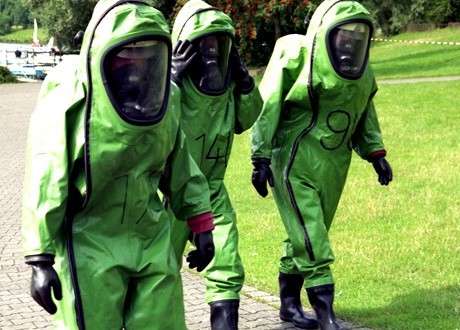Ebola first appeared in 1976 in 2 simultaneous outbreaks, in Nzara, Sudan, and in Yambuku, Democratic Republic of Congo. The latter was in a village situated near the Ebola River, from which the disease takes its name.
Ebola virus disease (EVD), formerly known as Ebola haemorrhagic fever, is a severe, often fatal illness in humans.
There are five identified subspecies of Ebolavirus. They are:
- Bundibugyo ebolavirus (BDBV)
- Zaire ebolavirus (EBOV)
- Reston ebolavirus (RESTV)
- Sudan ebolavirus (SUDV)
- Tai Forest ebolavirus (TAFV).
BDBV, EBOV, and SUDV have been associated with large EVD outbreaks in Africa, whereas RESTV and TAFV have not. The RESTV species, found in Philippines and the People's Republic of China, can infect humans, but no illness or death in humans from this species has been reported to date.
Transmission
Ebola then spreads in the community through human-to-human transmission, with infection resulting from direct contact (through broken skin or mucous membranes) with the blood, secretions, organs or other bodily fluids of infected people, and indirect contact with environments contaminated with such fluids.
The potential for widespread EVD infections is considered low as the disease is only spread by direct contact with the secretions from someone who is showing signs of infection.
Ebola is extremely infectious but not extremely contagious. It is infectious, because an infinitesimally small amount can cause illness. Laboratory experiments on nonhuman primates suggest that even a single virus may be enough to trigger a fatal infection.
Prognosis
The disease has a high mortality rate: often between 50 percent and 90 percent. As of April 2014, information from World health Organization (WHO) across all occurrences to date puts the overall fatality rate at 60%-65%. There are indications based on variations in death rate between countries that early and effective treatment of symptoms may reduce the fatality rate significantly. If an infected person survives, recovery may be quick and complete. Prolonged cases are often complicated by the occurrence of long-term problems, such as inflammation of the testicles, joint pains, muscle pains, skin peeling, or hair loss. Eye symptoms, such as light sensitivity, excess tearing, iritis, iridocyclitis, choroiditis, and blindness have also been described. Fatalities usually occur from low blood pressure (shock) rather than from blood loss.
Signs and Symptoms
The average time between contracting the infection and the start of symptoms (incubation period) is 8 to 10 days, but it can vary between 2 and 21 days, according to the Centers for Disease Control and Prevention. At first, it seems much like the flu: a headache, fever and aches and pains. Sometimes there is also a rash. Diarrhea and vomiting follow. In about 50% of cases skin manifestations may include a flat, red rash covered with small confluent bumps.
In 40-50% of cases, Ebola takes a severe turn, causing victims to hemorrhage. In the bleeding phase, which typically starts 5 to 7 days after first symptoms internal and subcutaneous bleeding may present itself through reddening of the eyes and bloody vomit. Bleeding into the skin also may occur. Types of bleeding known to occur with Ebola virus disease include vomiting blood, coughing it up, or blood in the stool. Heavy bleeding is rare and is usually confined to the gastrointestinal tract. In general, the development of bleeding symptoms often indicates a worse prognosis. But bleeding is not usually what kills patients. Rather, blood vessels deep in the body begin leaking fluid, causing blood pressure to plummet so low that the heart, kidneys, liver and other organs begin to fail, death due to multiple organ dysfunction syndrome occurs within 7 to 16 days (usually between days 8 and 9) after first symptoms.
People are infectious as long as their blood and secretions contain the virus. Ebola virus was isolated from semen 61 days after onset of illness in a man who was infected in a laboratory.
Treatment
No ebolavirus-specific treatment exists. Severely ill patients require intensive supportive care. The following basic interventions, when used early, can increase the chances of survival.
- Pain management Medications for nausea, fever, and anxiety.
- Providing oral and intravenous fluids.
- Balancing electrolytes (body salts).
- Maintaining oxygen status and blood pressure.
- Treating other infections if they occur.
Blood products such as packed red blood cells, platelets or fresh frozen plasma may also be used. Other regulators of coagulation have also been tried including heparin in an effort to prevent disseminated intravascular coagulation and clotting factors to decrease bleeding
A number of experimental treatments are being studied. The FDA has allowed two drugs, ZMapp and an RNA interference drug called TKM-Ebola, to be used in people infected with Ebola under these programs during the 2014 outbreak.
Quarantine
Quarantine, also known as enforced isolation, is usually effective in decreasing spread. Governments often quarantine areas where the disease is occurring or individuals who may be infected. In the United States, the law allows quarantine of those infected with Ebola.
Vaccine
No licensed vaccine for EVD is available. Several vaccines are being tested, but none are available for clinical use.


